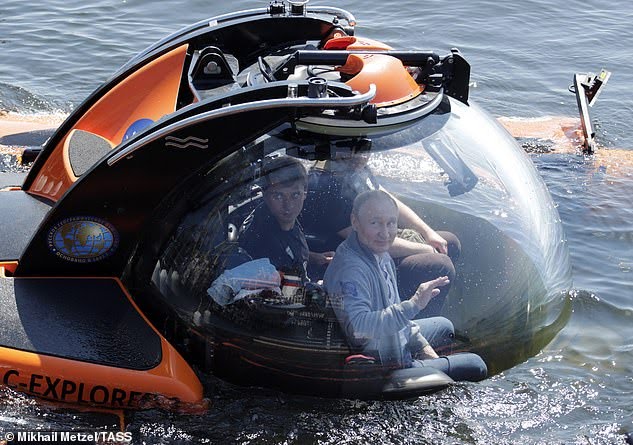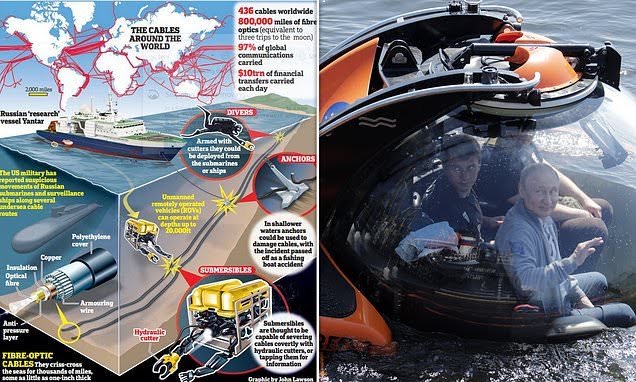•How Putin could black out Britain: Top military man warns Russian sabotage could wreck undersea cables that supply our internet and $10 trillion of financial deals a day
- 97 per cent of international communications are sent through sub-sea cables
- The cables linking all continents are thousands of feet below the ocean’s surface
- Admiral Sir Tony Radakin believes Russia could target this vital network
By David Wilkes
Thousands of feet under the ocean lies a global network of internet cables responsible for carrying 97 per cent of international communications.
In a digital age, these physical cables, sheathed in steel and plastic, are central to how we function. If they were to be disabled, it would not just prevent us accessing the web on our phones and laptops — it would disrupt everything from agriculture and healthcare to military logistics and financial transactions, instantly plunging the world into a new depression.
According to experts, this doomsday scenario ranks alongside nuclear war as an existential threat to our way of life.
And the newly appointed chief of the defence staff Admiral Sir Tony Radakin reckons Russia is the hostile power most likely to cripple these vital arteries.
In an interview at the weekend, he said there had been ‘a phenomenal increase’ in Russian submarine activity over the past 20 years, adding: ‘Russia has grown the capability to put at threat those undersea cables and potentially exploit them.’
Any such interference would be treated with the utmost seriousness. Asked whether destroying cables could be considered an act of war, Britain’s most senior military officer said: ‘Potentially, yes.’


The good news is the cable manufacturers do not make things easy for would-be saboteurs.
The cables, largely owned and installed by private companies, are designed to withstand the natural rigours under the sea and cannot be cut easily.
Typically just over an inch in diameter, they consist of fibre optics — strands of glass as thin as a hair — in the centre, surrounded by galvanised steel wire armouring and then, on the outside, a plastic coating.
They are engineered to the ‘five nines’ standard — meaning they are reliable 99.999 per cent of the time, a level generally reserved for nuclear weapons and space shuttles.
But, armed with hydraulic cutters attached to their hulls, Russian submersibles would make short work of the hosepipe-thin cables. Alternatively, divers or remotely operated vehicles (ROVs) fitted with cutters could do the job.
One ship identified as a serious threat is the Yantar. Officially described by the Russian navy as a ‘research’ ship, it carries two mini submarines designed for engineering missions which can examine areas up to 3.75 miles underwater.
Just four months after it took to the sea for the first time in 2015, Yantar triggered concern in intelligence circles when it was detected just off the U.S. coast on its way to Cuba where undersea cables make landfall near Guantanamo Bay.
Russian President Vladimir Putin, pictured, commissioned research vessels which can target sub sea cables https://secured.dailymail.co.uk/embed/gamp-video/10388139/video-1700082.html#amp=1
https://secured.dailymail.co.uk/embed/gamp-video/10388139/video-1700082.html#amp=1
In shallower waters, a vessel could deliberately drag an anchor along the seabed to rip the cables apart. Such an attack could be covered up by passing it off as an innocent fishing-boat accident.
Last August, the Yantar was seen off Ireland’s Donegal-Mayo coastline. Despite having territorial waters ten times the size of its land mass, Ireland has just one naval vessel to monitor the four cables that link it to the U.S. and the eight connecting it to Britain. Out at sea, the cables are even more vulnerable, as they are often hundreds or thousands of miles from the nearest naval bases capable of identifying, monitoring and intercepting hostile ships.
There are also fears that Yantar’s submersibles could carry technology capable of tapping the cables.
Around the world there are 436 of these cables, containing between them more than 800,000 miles of fibre optics.
The daddy of them all is the Asia American Gateway which is 12,430 miles long.
Each cable contains between four and 200 optical fibres — one fibre can transmit as much as 400GB of data per second, or enough for about 375 million phone calls.
A single cable containing eight fibre-optic strands could transfer the contents of Oxford’s Bodleian Library — which contains more than 12 million books, journals and manuscripts — across the Atlantic in about 40 minutes.
They are far more important than satellite communications, which account for just 3 per cent of global traffic. As futuristic as satellites may sound, this mode of transmission has been in decline since the early 1990s as fibre-optic cables gained the ascendance.
‘Short of nuclear or biological warfare, it is difficult to think of a threat that could be more justifiably described as existential than that posed by the catastrophic failure of undersea cable networks as a result of hostile action,’ states a report from the Policy Exchange think-tank written in 2017 by the now Chancellor Rishi Sunak, who was then a backbench MP.
Every day the cable network carries $10 trillion worth of financial transfers. The report says: ‘In the words of the managing director of one major telecoms firm: “Cascading failures could immobilise much of the international telecommunications system and internet . . .
‘The effect on international finance, military logistics, medicine, commerce and agriculture in a global economy would be profound . . . Electronic funds transfers, credit card transactions and international bank reconciliations would slow . . . such an event would cause a global depression”.’
Sunak’s report recommended that undersea cables should be designated as critical national infrastructure and ‘cable protection zones’ should be established.
Meanwhile, British ships and other military assets protect cables in areas such as the North Atlantic. Last week it emerged the sonar equipment of one of those ships, a frigate called HMS Northumberland, was crashed into by a Russian submarine in late 2020.
At the time of the collision, the ship had deployed a Towed Array, a tube up to two miles long fitted with hydrophones to listen under the water, and it is this element the sub is believed to have hit.
As tensions rise between Russia and the West over countries like Ukraine and Kazakhstan, such incidents are likely to become a lot more common.
Credit | Daily Mail

